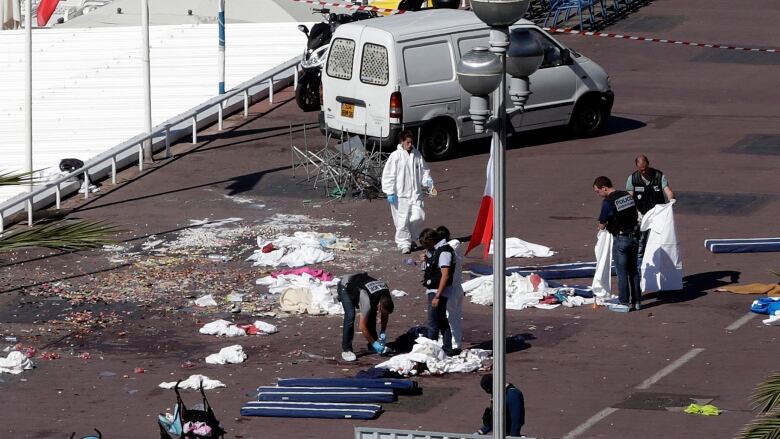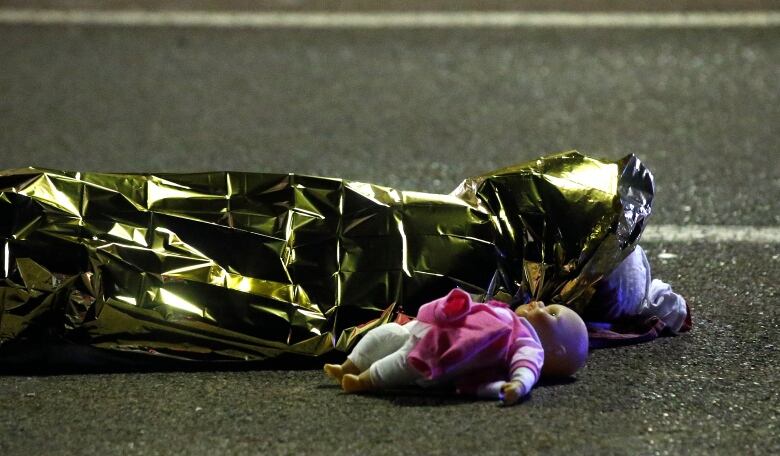Puppies, selfies, corpses: How graphic images on social media can change your brain
'With enough viewing ... somebody could be traumatized second-hand,' psychologist says

WARNING:This story containsagraphicphotograph.
Broken bodies lie twisted on the roadway, some piled on top of one another, many smeared with the red of blood the carnage a sign that what began as a normal day had taken a horrific, irreversible turn.
Is this Paris? Syria? Orlando? Baghdad?
On Thursday, it was Nice.
As graphic video circulatedof a truck plowing down revellers gathered for Bastille Day fireworks in the south of France, CBC News chose not to show it.
"Usual rules apply. We cover the story. We refrain from using footage that'sespecially gruesome ... unless it serves a very serious journalistic purpose," CBC's director of journalistic standards and practices DavidStuderwrote in a note to the organization.
- A scene of horror': 84 dead, including children, after truck plows into Bastille Day crowd in France
- Truck plows into Bastille Day crowd in Nice, France, 84 dead
- Bastille Day truck attack kills dozens in Nice
But the seemingly endless stream of international terror attacks is mirrored in the newsfeeds of virtually every social media user. You log into your Facebook account to check out a photo of your friend's new puppy and instead find photos of corpses.
'Sense of a lack of control'
That deluge of graphic images and video can have a cumulative effect even on people a world away from the scene, Toronto psychologist Dr. Oren Amitay says, with social media contributing to insecurity, tension and the anxiety that your city could be the next target.

"With enough viewing, we are now coming to understand that somebody could be traumatized second-hand," Amitay told CBC News. "If you're always seeing it then you have the sense that this is the norm, then you have the sense that the world is far more dangerous than it is."
It's essentially second-hand trauma,Amitay says.
And he said the latest edition of the diagnostic manual for mental illness takes into account the fact that a person can be traumatized by repeated exposure to violent images.
"Most people without a history of trauma will not be traumatized but someone who has trauma in their life can be triggered" by the images, Amitay said.
And one of trauma's key symptoms, is the sense of having no control, Amitay says.
Constant feartaxes people
"When someone hears about these incidents, even if it's in another country, it can trigger that sense of, 'There was nothing anyone could have done about it,'" Amitay said. "It affects your physiology, it affects the way you think, the way you see yourself, the way you see the future You become hyper-alert, hyper-vigilant.
"Even if you never actually had the experience, you could develop the physiological symptoms that go would along with such a terrible experience."
And being constantly fearful of danger particularly when that danger doesn't materialize can have a real effect.
"If you're always walking around feeling that you're constantly at risk, we do know that it taxes the brain and the body," Amitay says. "You're always on high alert and the body's not meant to do that. The body is meant to dispel that energy."
'Very little you can do'
Canada is not France and Toronto is not Nice, but some in this city worry an attack here might not be far off.
"It hasn't hit right here but it's only a matter of time It's something that you think about," Torontonian Jeanine Robins said.

"I feel like the depressing thing is this the norm. This isn't even news at this point and that to me is the more scary thing than the attacks itself," Lux Yogasegaram, another Torontonian, said.
Amitay says it's important to realize that danger is possible, but not to allow those fears to govern a person's life.
"Invoking fear is the goal of terrorism. You want to make your enemies constantly afraid ... So it's not unnatural that people are feeling that way but we should try our best not to succumb to those feelings."
On Friday, Torontonians held a vigil at Nathan Phillips Square to honour the victims of the attack in Nice.
A 22-year-old man studying in Edmonton is missing after the attack. Mykhaylo Bazelevskyy is a Ukrainian national who received permanent residency in Canada.No Canadianshave been reported missing.

Corrections
- An earlier version of this story stated at least one Canadian is missing after the Nice attack. In fact, the missing person referenced is Mykhaylo Bazelevskyy, a Ukrainian national who received permanent residency in Canada. No Canadians have been reported missing.Jul 16, 2016 9:28 AM ET
With files from Sneha Kulkarni













_(720p).jpg)


 OFFICIAL HD MUSIC VIDEO.jpg)
.jpg)



























































































